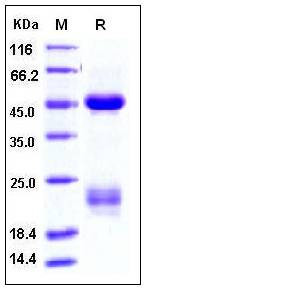Human Coagulation Factor X / FX / F10 Protein (His Tag)
FX,FXA
- 100ug (NPP3750) Please inquiry
| Catalog Number | P11076-H08B |
|---|---|
| Organism Species | Human |
| Host | Baculovirus-Insect Cells |
| Synonyms | FX,FXA |
| Molecular Weight | The recombinant human coagulation factor X consists of 468 amino acids and predicts a molecular mass of 52.8 kDa. As a result of glycosylation, it migrates with the apparent molecular mass of approximately 48 and 22 kDa corresponding to the cleaved light and heavy chain respectively in SDS-PAGE under reducing conditions. |
| predicted N | Asn 32 |
| SDS-PAGE |  |
| Purity | > 97 % as determined by SDS-PAGE |
| Protein Construction | A DNA sequence encoding the full length of human coagulation factor X (NP_000495.1) (Met 1-Lys 488) was expressed with a polyhistidine tag at the C-terminus. |
| Bio-activity | |
| Research Area | Immunology |Inflammation / Inflammatory Mediator |Plasma Cascade Systems in Inflammation |Coagulation |Intrinsic |
| Formulation | Lyophilized from sterile 50mM Tris, 100mM NaCl, pH 8.0, 10% glycerol 1. Normally 5 % - 8 % trehalose, mannitol and 0.01% Tween80 are added as protectants before lyophilization. Specific concentrations are included in the hardcopy of COA. |
| Background | Coagulation factor X, also known as FX, F10, Eponym Stuart-Prower factor, and thrombokinase, is an enzyme of the coagulation cascade. It is one of the vitamin K-dependent serine proteases, and plays a crucial role in the coagulation cascade and blood clotting, as the first enzyme in the common pathway of thrombus formation. Factor X deficiency is one of the rarest of the inherited coagulation disorders. FX deficiency among the most severe of the rare coagulation defects, typically including hemarthroses, hematomas, and umbilical cord, gastrointestinal, and central nervous system bleeding. Factor X is synthesized in the liver as a mature heterodimer formed from a single-chain precursor, and vitamin K is essential for its synthesis. Factor X is activated into factor Xa (FXa) by both factor IX (with its cofactor, factor VIII in a complex known as intrinsic Xase) and factor VII (with its cofactor, tissue factor in a complex known as extrinsic Xase) through cleaving the activation propeptide. As the first member of the final common pathway or thrombin pathway, FXa converts prothrombin to thrombin in the presence of factor Va, Ca2+, and phospholipid during blood clotting and cleaves prothrombin in two places (an arg-thr and then an arg-ile bond). This process is optimized when factor Xa is complexed with activated cofactor V in the prothrombinase complex. Inborn deficiency of factor X is very uncommon, and may present with epistaxis (nose bleeds), hemarthrosis (bleeding into joints) and gastrointestinal blood loss. Apart from congenital deficiency, low factor X levels may occur occasionally in a number of disease states. Furhermore, factor X deficiency may be seen in amyloidosis, where factor X is adsorbed to the amyloid fibrils in the vasculature. |
| Reference |
